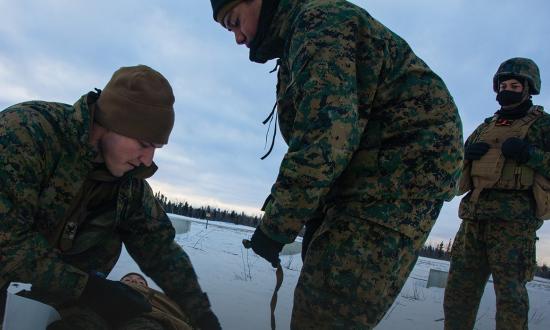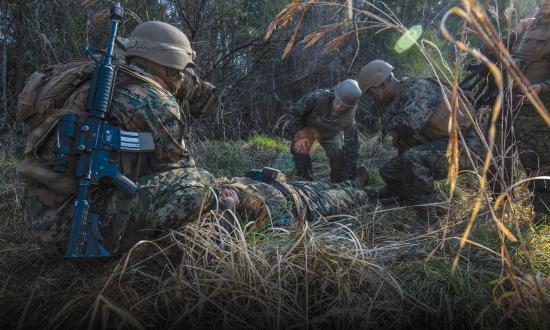Navy Medicine has been realigning since Rear Admiral Bruce Gillingham was confirmed as the 39th Navy Surgeon General in fall 2019. The stated goal is: “Navy Medicine will optimize to project medical power in support of Naval Superiority.”1 The Bureau of Medicine and Surgery has focused on readiness instead of delivering health benefits and beneficiary care.
While readiness is a difficult metric to define and measure, the Bureau of Medicine and Surgery has chosen to focus on four priorities: people, platforms, performance, and power. People focuses on organizing, manning, training, and equipping medical personnel for their support mission. Platforms focuses on capabilities needed by the fleet, including ambulance ships.2 Performance focuses on maintaining the skills of personnel, developing new collaboration, and leveraging improved analytics—including artificial intelligence. Power focuses on applying the other categories to readiness, thus enhancing soft- and hard-power projection.
To accomplish this, there has been an increased emphasis on tours with the operating forces. The Medical Corps’ career progression matrix has been updated to reflect an alternating cycle of operational and clinic-based medicine similar to the unrestricted line’s alternating sea-shore tour models of increasing responsibility.
Gone are the days when most general medical officers (GMOs), flight surgeons (FS), and undersea medical officers (UMOs) were interns out of basic training.3 Previously, operational medicine was only a track in the career progression and not the intent. A career-progression track now starts with a primary specialization and then alternating operational utilization tours as a GMO, FS, UMO, or ship’s medical officer (SMO). Some personnel will always come right from their initial intern training, but this will become increasingly rare.
Maintaining Operational Readiness
Despite this new focus on operational medicine, most Navy physicians do not keep their operational credentials active while in a hospital setting. For example, designated flight surgeons with subspecialty qualifications in other fields revert to their primary fields and typically no longer practice, or are not credentialed to practice, flight medicine. The Navy needs to change this. Physicians should apply for, and credentialing committees should adjudicate, packages including their operational medical qualifications. Navy Personnel Command should ensure that physicians eligible for dive or flight status are routed to billets in an active flight or dive status. This will bring the operational medicine focus back into the shore-side military treatment facilities (MTFs), such as Naval Hospital San Diego.
Since the 2017 National Defense Authorization Act was passed, the Department of Defense has been transitioning health benefit delivery from the independent services to the Defense Health Agency (DHA). The transition has been difficult, and the scope of the project continues to broaden. Many have compared the transition to driving a road as you pave it—an endeavor fraught with peril. Failing to bring operational medical concerns and activities into the MTFs will only worsen as the transition to DHA continues. The DHA uses joint providers and civilians who are not familiar with, or do not understand the requirements of, the Navy’s operating missions. Their primary focus is rendering care inside an MTF. This is why several services long ago created flight surgeons and other operational medicine specialties.
As a result of the MTFs’ organizational structure, operational concerns are forgotten. Gaps in care exist and solutions are slow in coming.4 Limited duty boards frequently are not started when they should be, and special duty limiting conditions are not addressed by subspecialists, as they believe that will be accomplished by another physician. This becomes a significant issue for those on shore tours without unit medical personnel or an operational medicine clinic. Members are only screened on reassignment to operational duty or as an administrative “up chit” on arrival back at a flying unit.
Other services occasionally conduct a medical screening prior to selection boards, including command screening boards. In my experience, the Navy’s lack of a similar structure or operational focus in the MTFs frequently has contributed to service members being disqualified to serve in command or return to an operational status, outcomes that could have been avoided if proper screening and adjudication happened earlier in a shore tour. For example, I have had many patients referred to me for flight physicals who have been nondeployable for longer than the Department of Defense’s one-year retention standards while undergoing chemotherapy and surgical care for cancer, without ever having been placed on a limited duty status.5 Timely adjudication of limited duty would allow space for orders modifications and special-duty waivers, reduce worry on the part of the member, decrease unnecessary permanent-change-of-station costs to the Navy, and ultimately return more members to a full-duty status.
While the Navy and Surgeon General’s pivot to operational medicine is the right approach, more needs to be done. The Navy needs to promote and practice operational medicine inside the MTFs and across the specialties. Operational providers need active credentials and special-duty status orders while serving in MTF billets. Information systems need to be updated to track duty status electronically at every visit, instead of only on paper, if at all. If Navy Medicine can bring an operational focus back into the MTFs, then it will truly be living up to the idea of being ready to “Fight Tonight.”6
1. Defense Visual Information Distribution Network, “U.S. Navy Surgeon General Releases Guidance to Fleet; Focuses on People, Platforms, Performance and Power,” 14 January 2020.
2. Sam LaGrone, “Navy’s $3.2B Unfunded List Includes Asks for Attack Boat Repair Money, ‘Ambulance’ Vessel,” USNI News, 25 March 2019.
3. “The New Medical Corps Career Progression Slide—What Does It Mean to You?” Joel Schofer’s Career Planning Blog, 12 April 2020,.
4. LaGrone, “Navy’s $3.2B Unfunded List;” Ben Werner, “Navy Medical Corps Worries Future Funding Cuts Will Result in Fewer Doctors,” USNI News, 30 November 2018; Benjamin Walrath et al., “Navy En Route Care: A 3-Year Review of 428 Navy Air Evacuations,” Military Medicine 182, no. 1 (March 2017): 162–66; LCDR Scott A. Wallace, USN, “Naval Air Transport of Wounded Patients Has an Operational Gap,” U.S. Naval Institute Proceedings 145, no. 4 (April 2019).
5. Department of Defense Instruction 1332.45: Retention Determinations for Non-Deployable Service Members, 1–20 (Arlington, VA: 2018).
6. David Ignatius, “The Marines’ New Commandant Has Set the Bar for Real Military Reform,” The Washington Post, 10 August 2019.







